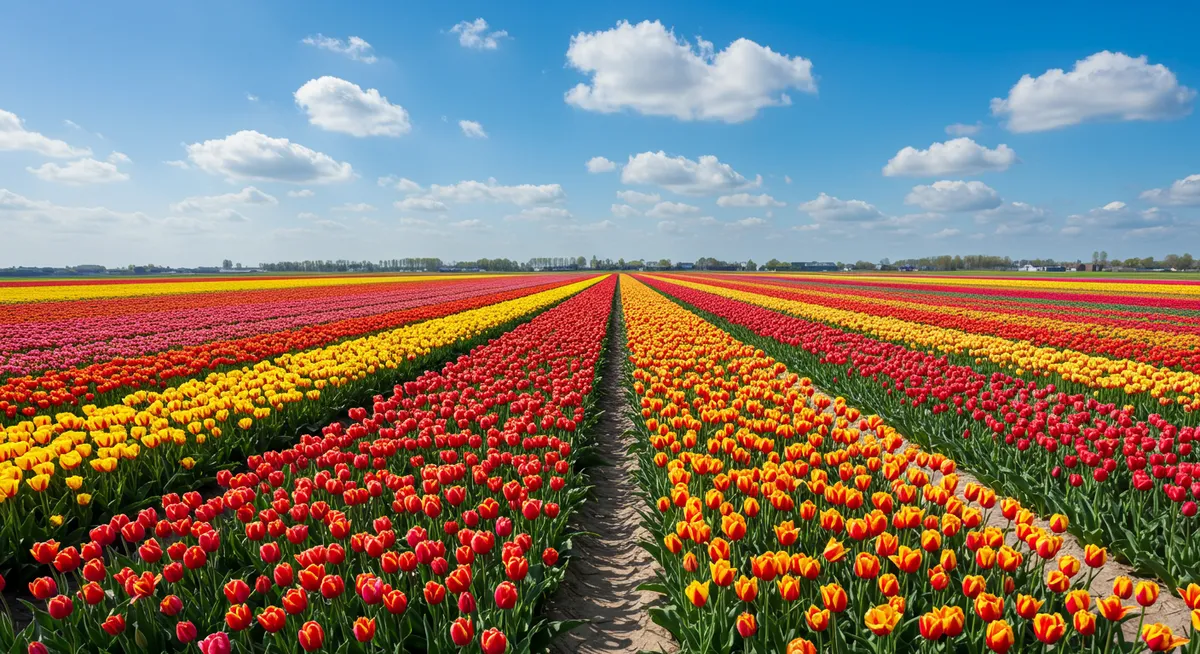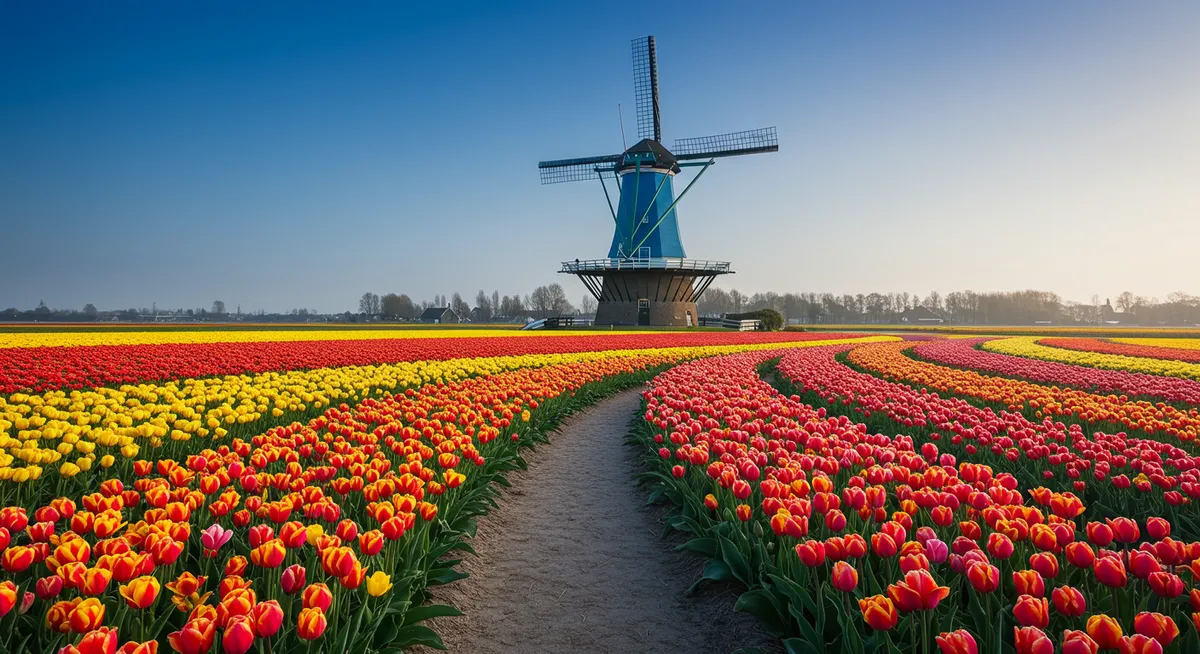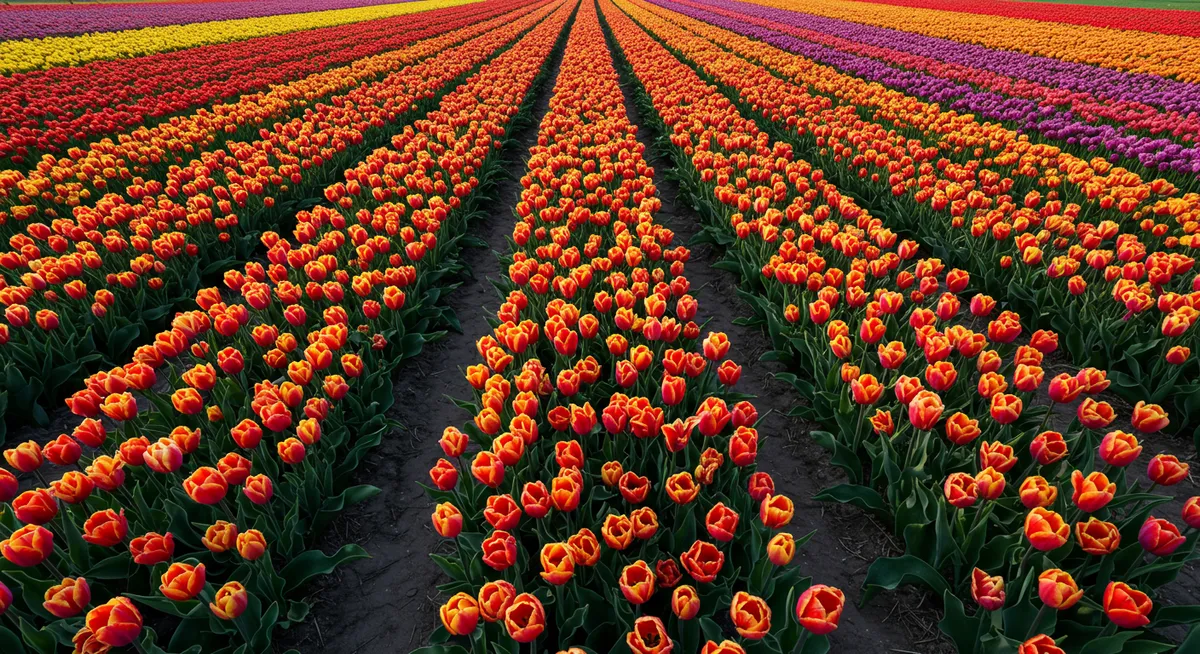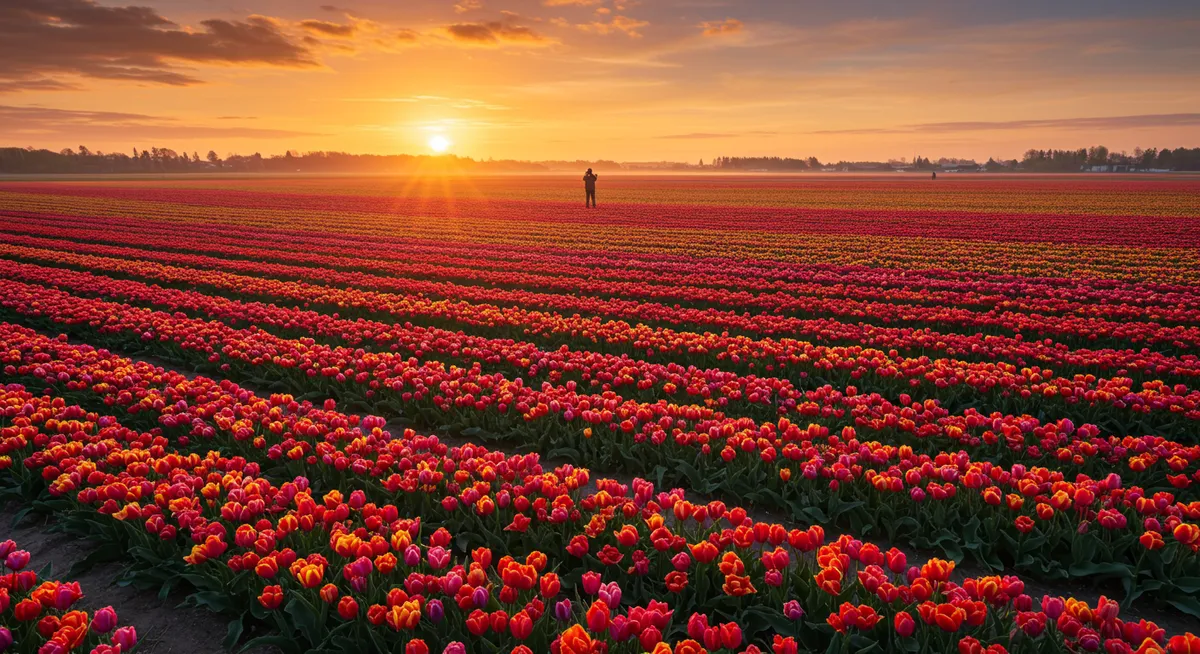Holland's Tulip Field Walking Routes: Spring's Most Colorful Landscapes

Holland's Tulip Field Walking Routes: Spring's Most Colorful Landscapes
From late March through mid-May, the Dutch countryside undergoes one of the world's most dramatic spring transformations as millions of tulips burst into bloom, creating vast carpets of color that stretch across the flat polder landscapes. While many visitors experience these iconic floral displays only from tour buses or bicycle paths, dedicated walking routes provide the most immersive way to experience the Netherlands' most celebrated seasonal spectacle. This guide explores the country's finest tulip field walking paths, where you can literally stroll through spring's most vivid color palettes.

The Dutch Tulip Phenomenon: More Than Just Flowers
The Netherlands' spring tulip displays represent far more than simple ornamental gardening—they embody a complex intersection of history, economics, and cultural identity:
- Historic Legacy: Contrary to popular belief, tulips are not native to the Netherlands but were imported from the Ottoman Empire in the 16th century, leading to the famous "tulip mania" economic bubble of 1637
- Agricultural Innovation: Today's stunning displays represent centuries of Dutch horticultural expertise, with over 3,000 registered tulip varieties
- Economic Powerhouse: The Netherlands produces approximately 4.3 billion tulip bulbs annually, with about 53% of global trade in floriculture products
- Living Laboratory: Commercial fields serve as both production spaces and testing grounds for new varieties
- Cultural Symbol: The tulip has become globally synonymous with Dutch identity and heritage
Understanding this context enhances appreciation for the walking routes that provide intimate access to this uniquely Dutch phenomenon. Unlike highly manicured display gardens like Keukenhof, walking routes through commercial growing areas showcase the authentic working landscapes where tulips are cultivated primarily for their bulbs rather than tourism.
While different in character from wild floral displays like American desert wildflower blooms or Himalayan flower valleys, Holland's tulip fields represent another of spring's most extraordinary color transformations—one shaped by centuries of human agricultural expertise rather than purely natural processes.
The Bollenstreek (Bulb Region) Walking Routes
Noordwijkerhout to Keukenhof Path
Perhaps the Netherlands' most accessible tulip walking experience connects the charming flower village of Noordwijkerhout with the famous Keukenhof gardens. This 7-kilometer marked path follows a series of quiet rural roads and dedicated footpaths that weave through the heart of the commercial bulb-growing region.
What makes this route particularly special is how it gradually transitions from working agricultural landscapes to more manicured display areas as you approach Keukenhof. Starting from Noordwijkerhout, walkers first experience authentic commercial fields—vast rectangles of single colors planted in precise rows. The middle section features smaller, more diverse growing plots where specialty bulb developers test new varieties, creating patchwork patterns of unexpected color combinations.
Strategic viewing platforms along the route provide elevated perspectives across the flat landscape, allowing walkers to appreciate the extraordinary geometric patterns created by different tulip varieties planted in adjacent fields. The final approach to Keukenhof offers glimpses of the park's more artistically arranged plantings, creating an instructive contrast between commercial production and ornamental design.
The Flower Ribbon Route (Bloembollenroute)
For those seeking a comprehensive tulip field walking experience, the 15-kilometer Flower Ribbon Route between Noordwijk and Lisse offers the region's definitive journey. While many travelers drive or cycle this iconic route, dedicated walking paths run parallel to much of the route, providing a more intimate experience.
This route's particular advantage is its diversity of bulb flowers beyond just tulips—in early April, fields of daffodils, hyacinths, and early tulip varieties create a multidimensional experience, while late April showcases peak tulip blooms in extraordinary variety. The region's sandy soil, perfect for bulb cultivation, was created by centuries of dune excavation and land reclamation, demonstrating the distinctively Dutch approach to landscape engineering.
Several recommended sections for walkers include the 3-kilometer stretch south of Noordwijkerhout, where footpaths directly border expansive tulip fields, and the 4-kilometer section approaching Lisse, where historic estates intermingle with flower cultivation. Local conservation initiatives have established wildflower corridors between commercial fields, creating habitat for pollinators and adding ecological context to the walk.

Flevoland: The New Frontier of Tulip Walking
Noordoostpolder Tulip Route
While the traditional Bollenstreek region remains the most famous tulip area, the Noordoostpolder in Flevoland province now hosts the Netherlands' largest single concentration of tulip fields. This extraordinary region exists on land reclaimed from the sea in the 20th century, with pristine soil ideal for bulb cultivation. Spanning over 100 kilometers, the complete Tulip Route primarily serves driving tourists, but two dedicated walking sections have been developed for flower enthusiasts.
The 8-kilometer Tulip Island Loop encircles an extraordinary concentration of fields near Creil, where more than twenty contiguous tulip fields create one of Europe's most spectacular spring landscapes. Unlike the smaller, irregular fields of the traditional bulb region, Flevoland's vast, geometric plots reflect modern agricultural efficiency, with some single-variety fields stretching nearly a kilometer in length.
The walking route includes several elevated viewing mounds constructed specifically to provide panoramic perspectives across these massive fields. What makes this area particularly photogenic is the extraordinary contrast between vibrant tulip colors and the region's distinctive open skies—the famous Dutch light celebrated by centuries of painters.
The Water Tulip Trail (Waterloopbos Route)
For a completely different tulip walking experience, the 6-kilometer Water Tulip Trail combines Flevoland's spectacular flower fields with its fascinating water management history. Beginning near Marknesse, this loop trail passes through the Waterloopbos, a forest containing historic hydraulic engineering test models, before emerging into vast open tulip fields.
The route's unique appeal comes from this juxtaposition of the Netherlands' two great national endeavors—water management and horticulture. Interpretive signs explain how the precise water table control made possible by Dutch engineering creates ideal conditions for tulip cultivation, with drainage systems maintaining exactly the right soil moisture for optimal bulb development.
Unlike more touristy routes, this path offers a quieter, more contemplative tulip experience, with fewer visitors and more opportunities to observe farmers tending their valuable crops. The trail includes several rest areas positioned to frame perfect views across fields containing some of the Netherlands' most innovative tulip varieties being grown for international markets.
Amsterdam Region Tulip Walks
Amstelveen Flower Trail
For visitors based in Amsterdam seeking an accessible tulip walking experience without traveling to the main growing regions, the 5-kilometer Amstelveen Flower Trail offers a perfect solution. Beginning at the Amsterdamse Bos (Amsterdam Forest), this urban-adjacent route passes through a series of specialized tulip display gardens before connecting to small-scale commercial growing fields on the city's periphery.
What distinguishes this walk is its educational focus on tulip variety development and urban green space integration. The route includes the Amstelveen Test Garden, where dozens of experimental tulip varieties undergo trials before commercial release, allowing walkers to potentially glimpse the tulip cultivars of the future. Unlike the vast monoculture fields of major growing regions, this area features smaller, more diverse plantings.
The trail also showcases how the Netherlands integrates productive agricultural spaces into its urban planning, with tulip fields serving as seasonal green belts that separate municipalities. Several observation platforms provide elevated views across the flat landscape, with Amsterdam's distant skyline creating a unique urban-rural contrast during peak bloom season.
The Aalsmeer Historical Tulip Path
Near Amsterdam's famous flower auction in Aalsmeer, a 4-kilometer historical walking route explores the origins of Dutch tulip cultivation. Unlike routes through modern commercial fields, this path connects several small historic estates where some of the Netherlands' earliest tulip collections were developed during the 17th century golden age.
The route includes restored gardens displaying heritage tulip varieties rarely seen in commercial cultivation, including dramatic "broken" tulips whose striped patterns (caused by a mosaic virus) commanded astronomical prices during the tulip mania period. Interpretive panels explain how these historic gardens influenced the development of the modern Dutch tulip industry.
While offering fewer vast field vistas than other routes, this walk provides the richest historical context for understanding the cultural significance of tulips in Dutch heritage. The route concludes near the Historische Tuin Aalsmeer (Historic Garden), where additional historic varieties can be viewed in a preserved setting that demonstrates traditional growing techniques.
North Holland's Alternative Tulip Walks
Island of Texel Tulip Path
For a completely different Dutch tulip experience, the island of Texel in the northern Netherlands offers a 12-kilometer marked route through an unusual tulip-growing environment. Unlike the carefully managed soils of traditional growing regions, Texel's tulip fields exist in a dynamic coastal ecosystem where brackish conditions create distinct growing challenges and opportunities.
The island's unique microclimate results in later blooming than mainland fields, with peak displays typically occurring in early May. The walking route traverses dune landscapes between tulip fields, creating dramatic visual contrasts between natural ecosystems and cultivated spaces. What makes Texel's tulips particularly special is how they're integrated into a mixed farming landscape alongside grazing sheep and other traditional island agriculture.
The path includes several unmarked side routes to elevated dunes providing spectacular views of fields backdropped by the North Sea. Walking this route offers insights into how Dutch tulip cultivation adapts to different environmental conditions, with varieties selected specifically for tolerance to coastal conditions being grown for specialized markets.
Den Helder Bulb Route
At the northernmost tip of mainland North Holland province, the 10-kilometer Den Helder Bulb Route offers perhaps the Netherlands' most dramatic landscape setting for tulip viewing. This coastal path alternates between vast commercial tulip fields and wild dune landscapes, with constant views of the nearby Wadden Sea creating a unique maritime context for the colorful displays.
What distinguishes this walk is the extraordinary quality of light—the combination of sea reflection, open sky, and flat terrain creates ideal conditions for photography, particularly in evening hours when the low sunlight intensifies the tulips' colors. The route includes several historic naval observation bunkers repurposed as tulip viewing platforms, offering elevated perspectives across fields that extend directly to the sea dikes.
Unlike more manicured tulip experiences, this route showcases the working reality of commercial bulb production in a challenging environment, with protective hedgerows and irrigation systems demonstrating the engineering required to grow perfect tulips in coastal conditions. Local farms along the route often sell specialty bulb varieties developed specifically for saline-resistant properties.
Tulip Walking Practicalities and Etiquette
Understanding the Blooming Calendar
The Netherlands' tulip displays follow a relatively predictable seasonal progression, though exact timing varies with each year's weather conditions:
- Late March: Early varieties begin blooming, with indoor forced tulips available for viewing
- Early-Mid April: First wave of outdoor tulips reaches peak bloom, particularly in warmer southern regions
- Late April: Main outdoor tulip season reaches maximum color intensity across primary growing regions
- Early May: Later varieties and northern regions reach peak bloom
- Mid-May: Blooming concludes as growers "head" tulips (remove flower tops) to direct energy to bulb development
For walkers seeking peak displays, the last week of April typically offers optimal conditions in the main Bollenstreek region, with Flevoland and northern areas peaking slightly later. Several smartphone apps and websites now provide real-time "bloom maps" showing current flowering conditions across different regions.
This carefully monitored bloom schedule parallels the timing considerations needed when planning visits to see Japan's cherry blossoms or Europe's bluebell woods, where the spectacular displays are equally fleeting and timing-dependent.
Respecting Commercial Agriculture
While visually stunning, it's crucial to remember that tulip fields represent commercial agriculture rather than public gardens. When walking tulip routes:
- Never enter fields without explicit permission—walking on planted areas damages valuable crops
- Observe flowers from designated paths and platforms rather than field edges
- Never pick flowers—removing blooms reduces the energy returned to bulbs and spreads diseases
- Keep dogs leashed and on paths to prevent contamination of commercial growing areas
- Yield to agricultural vehicles and workers, whose needs take priority during this busy season
Many routes now feature designated "selfie fields"—small areas specifically planted for visitors to photograph and experience tulips up-close without impacting commercial crops. These provide excellent opportunities for the floral immersion experience many visitors seek.
Beyond Tulips: The Complete Spring Bulb Experience
While tulips dominate the Netherlands' spring floral fame, dedicated walking routes offer opportunities to appreciate the nation's broader bulb cultivation heritage. Early-season walks in late March and early April showcase spectacular daffodil and hyacinth displays before tulips reach their peak. Hyacinths provide an additional sensory dimension through their intense fragrance, which often perfumes the air for considerable distances around growing fields.
Several routes, particularly in the traditional Bollenstreek region, pass by specialized growers focusing on minor bulb varieties including fritillaries, alliums, and muscari. These create distinctive visual textures among the more uniform tulip fields. Late-season walks in May offer chances to see spectacular allium fields, whose spherical purple blooms create otherworldly landscapes as the tulip season concludes.
This progression of different flowering periods means the dedicated bulb enthusiast can enjoy distinctive walking experiences across nearly two months of spring, with each week offering different color palettes and floral compositions across the Dutch landscape.
Photography Tips for Tulip Field Walks
The Netherlands' tulip fields present unique photographic opportunities and challenges. The extraordinary color saturation of the flowers often exceeds what camera sensors can accurately reproduce, while the flat landscape requires thoughtful composition to create engaging images. For best results, photograph in early morning or late afternoon when lower sun angles create texture through shadows and reduce the harsh contrast of midday light.
Consider incorporating the distinctive elements of Dutch landscapes—windmills, canals, historic farmhouses—to provide context and scale to tulip field images. Many walking routes strategically pass by such features specifically to create iconic photographic opportunities. For close-up flower photography, overcast days actually provide ideal conditions, functioning as a natural diffuser for capturing the subtle details and colors of individual blooms.
Several walking routes now include elevated platforms specifically designed for photography, providing perspectives that capture the geometric patterns and color blocks of commercial fields. These locations often become busy during peak season, making early morning visits advantageous for unobstructed views. Unlike the more intimate, enclosed settings of ancient woodland paths, tulip field photography benefits from the landscape's open horizons and dramatic perspective lines.

The Future of Dutch Tulip Landscapes
The Netherlands' famous tulip landscapes face both challenges and opportunities in coming years. Climate change has already shifted traditional growing patterns, with warming temperatures advancing the flowering season by approximately two weeks compared to historical averages. This shift requires adjustments for both commercial growers and tourism planning.
Simultaneously, growing concerns about pesticide use and biodiversity loss have inspired new approaches to tulip cultivation. Several walking routes now include sections passing through organic bulb fields and experimental plots utilizing biological pest controls. These areas often feature information about sustainable cultivation practices and the research developing resilient tulip varieties requiring fewer chemical inputs.
The newest tulip walking routes incorporate these sustainability themes, with paths designed to showcase both traditional cultivation and innovative approaches representing the future of Dutch horticulture. Several routes now include restored habitat areas between commercial fields, demonstrating how production landscapes can integrate biodiversity support through thoughtful design—an approach increasingly important for all spring destinations from alpine meadows to bird migration habitats.
Cultural Connections Along Tulip Routes
Walking the Netherlands' tulip routes provides opportunities to engage with the cultural dimensions of this iconic Dutch industry. Several paths pass by family bulb farms offering tours of their operations, where visitors can learn about the year-round cultivation cycle and the generations of expertise behind the perfect spring displays. These small-scale producers often maintain collections of historic varieties and specialized cultivars not seen in mass commercial production.
In the traditional Bollenstreek region, walking routes connect to museums documenting the region's bulb heritage, including the Black Tulip Museum in Lisse and the Bulb Museum in Limmen. These institutions provide context for understanding how tulips transformed from exotic luxury items to international icons of Dutch identity and agricultural innovation.
Seasonally, the famous Dutch flower parades (Bloemencorso) create additional cultural experiences along some tulip routes, with elaborate floral floats using tulips and other spring flowers to create moving artworks that process through bulb-growing communities, celebrating the region's horticultural heritage with music and festivities.
Explore More Spring Nature Wonders
Holland's tulip fields represent just one of spring's spectacular floral transformations across the globe.
Discover other breathtaking seasonal phenomena in our guide to Spring Nature Walks Around the World.